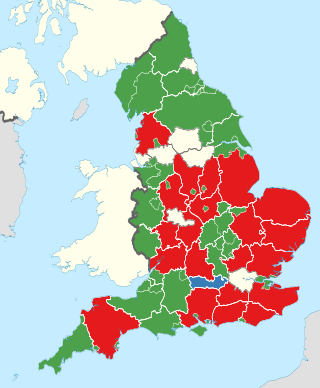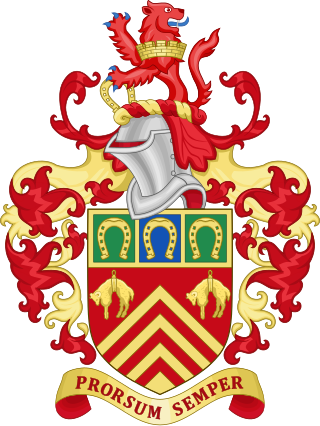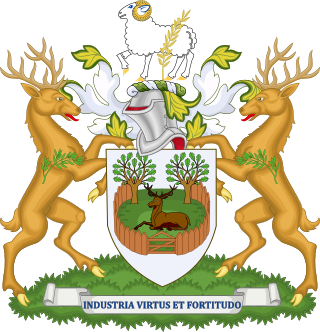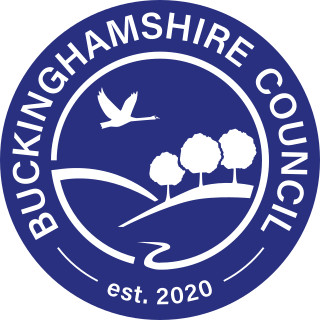
Hampshire County Council (HCC) is the upper-tier local authority for the non-metropolitan county of Hampshire in England. The council was created in 1889. The county council provides county-level services to eleven of the thirteen districts geographically located within the ceremonial county of Hampshire. The county council acts as the upper tier of local government to approximately 1.4 million people. It is one of 21 county councils in England.

The counties of England are divisions of England. Counties have been used as administrative areas in England since Anglo-Saxon times. There are two main legal definitions of the counties in modern usage: the 84 counties for the purposes of local government, and the 48 counties for the purposes of lieutenancy, also termed the ceremonial counties.

Ceremonial counties, formally known as counties for the purposes of the lieutenancies, are areas of England to which lord-lieutenants are appointed. They are one of the two main legal definitions of the counties of England in modern usage, the other being the counties for the purposes of local government legislation. A lord-lieutenant is the monarch's representative in an area. Shrieval counties have the same boundaries and serve a similar purpose, being the areas to which high sheriffs are appointed. High sheriffs are the monarch's judicial representative in an area.

A non-metropolitan county, or colloquially, shire county, is a subdivision of England used for local government.

Isle of Wight Council, known between 1890 and 1995 as Isle of Wight County Council, is the local authority for the Isle of Wight in England. Since 1995 it has been a unitary authority, having also taken on district-level functions when the county's districts were abolished. It is based at County Hall in Newport. The council has been under no overall control since 2021, being led by a coalition of independent, Green, and Our Island councillors called the Alliance Group.

The Borough of Darlington is a local government district with borough status in County Durham, England. Since 1997 Darlington Borough Council has been a unitary authority, with both district-level and county-level functions; it is independent from Durham County Council. It is named after its largest settlement, the town of Darlington, where the council is based. The borough also includes a rural area surrounding the town which contains several villages. The population of the borough at the 2021 census was 107,800, of which over 86% (93,015) lived in the built-up area of Darlington itself.

Northumberland County Council is the local authority for the non-metropolitan county of Northumberland in North East England. Since 2009 it has been a unitary authority, having also taken over district-level functions when the county's districts were abolished.

The unitary authorities of England are a type of local authority responsible for all local government services in an area. They combine the functions of a non-metropolitan county council and a non-metropolitan district council, which elsewhere in England provide two tiers of local government.

The Local Government Commission for England was the body responsible for reviewing the structure of local government in England from 1992 to 2002. It was established under the Local Government Act 1992, replacing the Local Government Boundary Commission for England. The Commission could be ordered by the Secretary of State to undertake "structural reviews" in specified areas and recommend the creation of unitary authorities in the two-tier shire counties of England. The Commission, chaired by John Banham, conducted a review of all the non-metropolitan counties of England from 1993 to 1994, making various recommendations on their future.

Gloucestershire County Council is the upper-tier local authority for the non-metropolitan county of Gloucestershire, in England. The council was created in 1889. The council's principal functions are county roads and rights of way, social services, education and libraries, but it also provides many other local government services in the area it covers. The council's administrative area does not include South Gloucestershire, which is a unitary authority with all the functions of a county and a non-metropolitan district. The council is based at Shire Hall in Gloucester.

Wiltshire Council, known between 1889 and 2009 as Wiltshire County Council, is the local authority which governs the non-metropolitan county of Wiltshire in South West England. Since 2009 it has been a unitary authority, having taken over district-level functions when the county's districts were abolished. The non-metropolitan county of Wiltshire is smaller than the ceremonial county of the same name, the latter additionally including Swindon. Wiltshire Council has been controlled by the Conservative Party since 2000, and has its headquarters at County Hall in Trowbridge.

Portsmouth City Council is the local authority of the city of Portsmouth, Hampshire, England. It is a unitary authority, having the powers of a non-metropolitan county and district council combined. It provides a full range of local government services, including Council Tax billing, libraries, social services, town planning, waste collection, and disposal, and it is a local education authority.

North Yorkshire Council, known between 1974 and 2023 as North Yorkshire County Council, is the unitary authority which governs the non-metropolitan county of North Yorkshire, England. It is one of five unitary authorities which governs the larger ceremonial county of North Yorkshire. The council is based at County Hall, Northallerton, and consists of 90 councillors. It is a member of the York and North Yorkshire Combined Authority.

Durham County Council is the local authority which governs the non-metropolitan county of County Durham in North East England. Since 2009 it has been a unitary authority, having taken over district-level functions when the county's districts were abolished. The non-metropolitan county is smaller than the ceremonial county of County Durham, which additionally includes Darlington, Hartlepool and the parts of Stockton-on-Tees north of the River Tees. The county council has its headquarters at County Hall in Durham.

Bracknell Forest Council, also known as Bracknell Forest Borough Council, is the local authority for Bracknell Forest, a local government district with borough status in Berkshire, England. The council is a unitary authority, being a district council which also performs the functions of a county council. The council has been under Labour majority control since 2023. It is based at Time Square in Bracknell.

Derby City Council is the local authority for Derby, a unitary authority with city status in the East Midlands region of England.

Brighton and Hove City Council is the local authority for Brighton and Hove, a local government district with city status in the ceremonial county of East Sussex, England. The council is a unitary authority, being a district council which also performs the functions of a county council. The council has been under Labour majority control since 2023. It is based at Hove Town Hall.

East Riding of Yorkshire Council is the local authority for the East Riding of Yorkshire, a local government district within the larger ceremonial county of the same name. It is a unitary authority, being a district council which also performs the functions of a county council. The council has been under no overall control since 2023, being led by a Conservative minority administration. It is based at County Hall in Beverley.

Wokingham Borough Council is the local authority of the Borough of Wokingham in Berkshire, England. It is a unitary authority, being a district council which also performs the functions of a county council.

Buckinghamshire Council is the local authority for the non-metropolitan county of Buckinghamshire in England. It is a unitary authority, performing both county and district-level functions. It was created on 1 April 2020, replacing the previous Buckinghamshire County Council and the councils of the four abolished districts of Aylesbury Vale, Chiltern, South Bucks, and Wycombe. The non-metropolitan county is smaller than the ceremonial county, which additionally includes Milton Keynes.



















